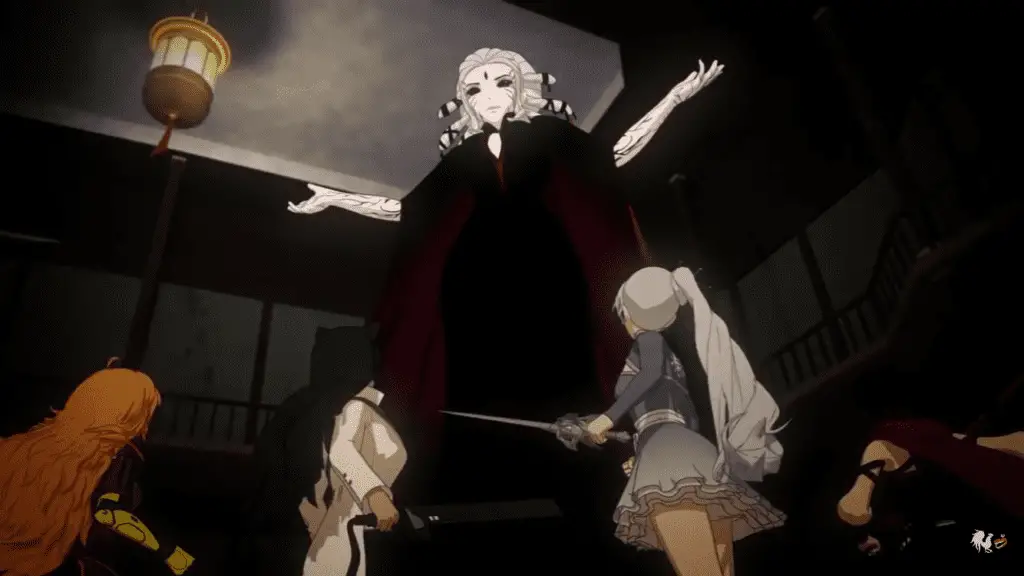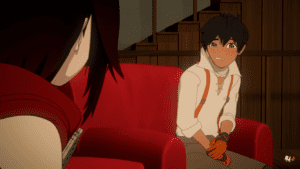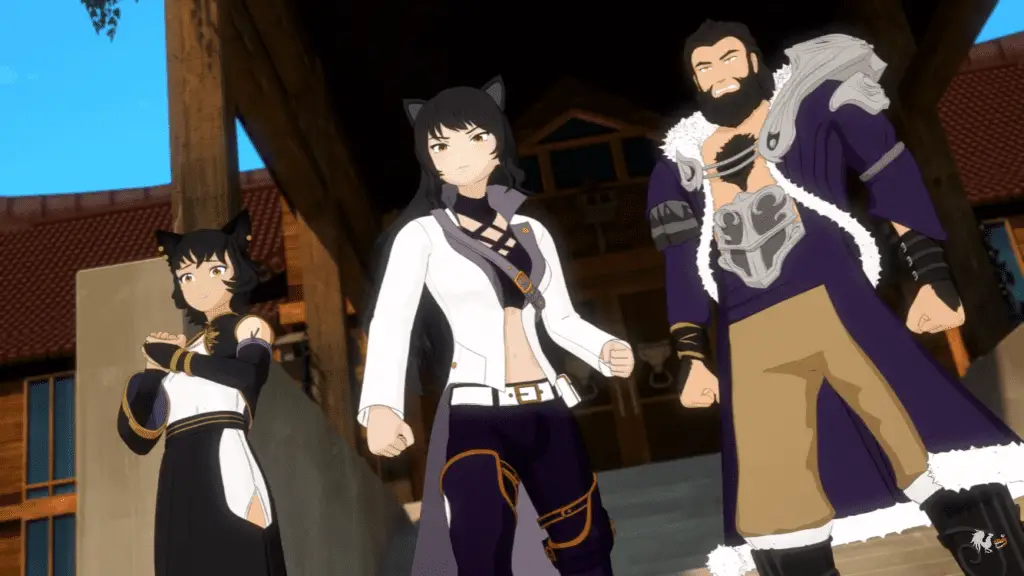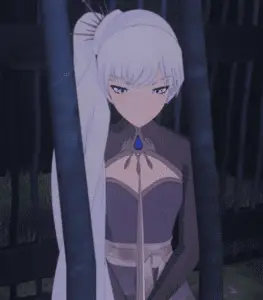Well folks, the ridiculous weapons have been put away, “From Shadows Part 2” has been replayed half a million times, and RWBY Volume 5 is done! To celebrate the end of the longest volume of RWBY ever (and hopefully tide us over until the soundtrack comes out), I’ll be digging into the first four episodes of RWBY Volume 5. Were they well-written? Were they an improvement on Volume 4? And most importantly, were they fun?
YES. YES. AND YES.
Okay, maybe I’m being a little too enthusiastic and making V5 sound like the best thing since sliced bread, but there’s no denying that the first four episodes of V5 are far better than the first four of V4. The animation, the pacing, the tone, the fights…gaah, they’re just so good!
I apologise for the fanboying, but these episodes feel so much more like the show I fell in love with three years ago. I don’t think I’ll be causing any controversy when I say that V4’s reception among fans was mixed. While the story had absolutely earned the darker, sadder tone, it felt like somewhere along the way the spirit of RWBY had been lost.
And the sad thing is, I’m not being metaphorical. Monty Oum’s tragic passing in February 2015 left a hole in the hearts of the RWBY community, and undoubtedly devastated the cast and crew of the show. While meta is often used for humour or political commentary, it’s rare to see it used as such a poignant expression of grief. While V4 may have been about the characters recovering from the death of Pyrrha, the death of Oum makes it all the more impactful.
And yet amidst all this sorrow, it truly is a smaller, more honest soul that ignites hope. Ruby’s monologue in the V4 finale is one of the greatest moments in the entire series. The way it uses the soundtrack is nothing short of brilliant, and while I could easily write a whole article on it, there’s one line I want to draw attention to:
“But it sure would be great to get team RWBY back together again.”
This. This line encompasses the entire journey of V4 and why I love the first four episodes of V5. It’s the shift in the narrative away from the sorrow and gloom of V4 back to the RWBY we all know and love. Back to the laughs, the love, the fights, everything that makes RWBY the series we all adore. Or as the V5 opening ‘Triumph’ put it, “Back to the fairytale, back to the show.”
So, without further ado, let’s discuss what makes “Welcome to Haven”, “Dread in the Air”, “Unforeseen Complications”, and “Lighting the Fire” so great.

Story
If there was one thing that made these four episodes work so damn well, it was the pacing. “Welcome to Haven” serves as a fantastic premiere episode, deftly laying the groundwork for our four protagonists in record time…literally. The Weiss portion of the episode lasts for all of 90 seconds, while the Blake and Yang segments clock in at 2 minutes apiece.
And yet in those tiny episode fragments, the storylines for each of the three girls are clearly established. We know Weiss is going to Mistral to find her sister, we know that Blake and her family are planning on unveiling the White Fang’s sinister schemes to the population of Menagerie, and we know that Yang is hunting down her mother.
Granted, it’s not entirely thanks to “Welcome to Haven” that we know all this, as the last two episodes of V4 laid the groundwork for this volume’s storylines. But nonetheless, this episode alone works as a better start to the plot than the entirety of the first four episodes of V4. And yes, I know I’ve been bringing up V4 a lot for a review of V5, but comparing the narrative structure of the two is critical to understanding why V5’s pacing is so much better.
RWBY V4 saw some fundamental changes in the way the series was structured, the most noticeable being that our four heroines were no longer together, but on their own separate journeys. To be clear, I don’t have a problem with this idea in and of itself—it’s just the way the writers [1] handled it. V4 spends its first four episodes focusing mostly on one heroine an episode. The Next Step focuses mostly on Ruby and team RNJR, Remembrance focuses on Weiss…you get the idea.
And this. Did. Not. Work.

I’m fine with taking time to familiarize the audience with the main characters after a series-changing event like the second half of V3. I’m fine with how it takes time to lay groundwork so that the plot can develop organically. What I am not fine with is taking a third of a season to get your story going. While I appreciate the time and effort the writers invested into displaying the aftermath of the events of V3 on our four heroines, there has to be a balance between setup and story progression-and V5 strikes this balance brilliantly.
Though the first four episodes of V5 follow the same one-heroine-an-episode structure, there’s an enormous increase in quality, best shown in the RNJR storyline. With perhaps the exception of episode four, it never feels like the story is dragging its feet, even with the sizable exposition dumps in episode one and three. Not even five minutes into episode one, there’s already a sense of something wrong, with the lack of students and teachers at Haven Academy hinting at something sinister going on behind the scenes. Even though we already know it’s because Lionheart is working for Salem, the episode still does a great job of setting up for what’s to come. Episode three continues this further, with Oscar/Ozpin’s suspicions of Lionheart being smoothly blended into his/their backstory. And this backstory itself further builds up tension, with Oscar/Ozpin warning team RNJR (and by extension, the audience) that failing to defeat Salem is not an option.
One way to measure the success of any storyline’s pacing is to think about how much progress has been made over the course of a set number of episodes. And when considering the progress RNJR has made from “Welcome to Haven” to “Lighting the Fire”, it’s pretty reasonable. RNJR and Qrow have met up with Lionheart, Lionheart has informed Salem that Qrow is alive, RNJR has met Oscar/Ozpin and learnt more about him, and kicked off their training arc. Furthermore, this was spread out over four episodes so that we didn’t get too much too quickly. When that happens, it lessens the impact of each plot point and leaves fewer opportunities to build up tension, like the Yang arc does-but more on that later.
As the central narrative of the series, the pacing of the RNJR arc is extra important because it has a ripple effect on the other storylines. While the Weiss, Blake and Yang narratives are important, they’re focused on the heroines achieving their individual goals, whereas RNJR is primarily focused on progressing the core conflict of the series: everyone vs Salem. And when that central narrative doesn’t make enough progress, it feels like the entire show is slowing down, which we saw a lot of in V4 and the middle portion of V5. Fortunately though, for the first four episodes, the writers nail the pacing for the RNJR arc, and all of the plotlines benefit as a result.

Another example of great pacing came in the form of the Weiss arc. The only heroine to feature in all four of the first four episodes, her plot progresses smoothly and uninterrupted, with every episode featuring a different part of her narrative. Episode one is her traveling to Mistral, episode two is her fighting Grimm, episode three is her being imprisoned by Raven’s bandits, and episode four is her breaking out of captivity and reuniting with Yang (wholesomeness overload there, you have been warned). Much like the RNJR arc, it’s a solid start to V5. What prevents it from being a great start to V5 is the nature of the Weiss storyline.
As I’ve stated before, Weiss’s arc, along with Blake and Yang’s, is character-driven. The RNJR storyline on the other hand, is very much plot-driven. Great pacing and plot progression works really well for a plot-driven storyline, but for a character-driven storyline, it’s just not as effective. The Weiss plot is still enjoyable, yet the focus on plot over character diminish the impact of her scenes. But because this issue is more rooted in her characterization than the pacing of the story, I’ll be analysing this in the ‘character’ section of this review.
Speaking of diminish a character’s impact on her scenes…um, Miles and Kerry, you’re supposed to give your protagonist dialogue in their scenes? I know Blake is quiet and all, but it’s kind of weird when she has no lines in the episode that’s centered around her plotline. Just saying.
My poor attempts at a segue aside, Blake having no dialogue in episode three is a bit odd. I feel like it wouldn’t have stolen Ilia’s thunder for Blake to at least start her speech? It’s also a bit of a missed opportunity; having Blake fail in her speech in episode three would have made her successful speech in episode ten more rewarding.

Regardless, episodes one and three provide a solid foundation for her storyline this volume. There’s no wasted time between the aftermath of the Belladonna’s confronting Corsac and Fennec, and Ghira making his speech to the Faunus of Menagerie, which was a nice addition to a storyline that occasionally felt like it was dragging its feet in V4. Ghira’s failed attempts to rally the Faunus to save Haven was a nice little twist not just for giving Blake and co. a challenge to tackle this volume, but for the sake of fleshing out a realistic political narrative. Forgiveness is never an easy feat, and when discrimination is involved, it’s even more difficult, if not impossible.
Speaking of politics: it’s coup d’état time!
While the pacing of most of the storylines in episodes one to four of V5 is pretty spot on, there a couple of sore spots, the first of which is Adam Taurus. I understand that the writers are pressed for time, but it felt like a waste killing her off so early. Even if they’d just waited another episode or two for a private meeting between her and Adam, the resulting build up would have made for a more exciting scene, or even a nice little mid-volume cliff-hanger.

The second is, of course. Yang.
Now let’s be clear: I LOVED the characterisation of Yang in episodes one and four. But the pacing of her arc in these episodes was…disappointing. While it’s not unbearable, it noticeably undermines the impact of the reunion scene between Yang and her mother.
Here’s the thing: Yang’s complicated relationship with her mother has been part of her storyline since day one. The events of the ‘Yellow’ trailer only happen because she’s looking for information regarding her mother’s whereabouts. And ever since V2, there has been at least one scene per volume dedicated to Yang’s feelings towards Raven. Which is fine—there’s nothing wrong with a slow burn style of writing, especially when it does a tremendous job at fleshing Yang out as a character.
But because that set up is spread out over three volumes, the Yang-Raven plotline doesn’t pick up any momentum, especially when there’s a break of eight months between each volume’s release. [2] While V4 episodes nine, eleven and twelve do a great job of building anticipation for the Yang-Raven reunion, all that momentum had fizzled out in the eight months between the V4 finale and the V5 premiere, which makes everything that happens in the first four episodes feel much too fast.
If you’re binge watching the series this storytelling technique works, but for all the viewers watching in real time, it feels like V5 is jumping straight into the action without any regard to setup.

It makes the end of Yang’s quest to find Raven feel not like the end of some massive journey, but more like a detour. After all this time and effort, it feels unearned; almost like Yang didn’t even need to try that hard. And if that isn’t even enough, the reunion itself doesn’t even answer the question we’ve been asking since V2: why did Raven abandon Yang?
Honestly, it just feels lackluster. Which is a real shame, because most of the arcs have solid pacing. The RNJR, Weiss and even the Blake narratives of the first four episodes progress quickly enough to keep us hooked, but not so fast that the plot feels underwhelming. Sadly, the Yang arc was the odd one out. But as far as characterisation goes…well that’s another story.
Character
While these four episodes may have done wonders when it came to plot progression, the character component was…meh. RWBY doesn’t have the best track record when it comes to character development, and unfortunately episodes one to four didn’t completely escape that legacy.
The problem seems to be, for at least these four episodes, that the writers of RWBY aren’t very good at balancing character development and plot progression. The RNJR, Weiss and Blake arcs all did a great job at moving their respective storylines forward, but as for characterisation, there’s not really a lot to say. Apart from Yang, the characters are just sort of…there?
I feel that the best way to analyse this is through the Weiss narrative. It’s the only storyline to feature in all four episodes, but honestly, I think it would have benefited immensely from being stretched out to six or seven. Having Weiss reunite with Yang at the end of episode four meant that there wasn’t enough time to explore how Weiss would interact with the bandit tribe. How would she feel about the possibility of being sent back to her father? What would a conversation between her and Raven be like? How would she feel about the whole ‘survival of the fittest’ ideology that Raven and her group seem to abide by?

It just feels like the writer’s decision to compress the story came at the cost of Weiss’ character development. There were so many facets of her character that they could have explored, but the focus on getting her from Point A to Point B meant that the most we got was a quick scene of Weiss expressing to Vernal her distaste for the bandits’ lifestyle. And I get it—if Weiss had been stuck in Raven’s camp all the way up to episode seven for a mid-volume reunion with Yang, it might be a little too damsel-in-distress for some people’s liking. But even still, it would have been a great way of depicting the difficulties of escaping abusive relationships with the cycle of breaking away and getting sucked back in.
And while every character suffers from missed opportunities at some point or another, it felt particularly frustrating for Weiss’s arc as she was essentially taken out of her own storyline and forced into Yang’s. Weiss has always shined when the plot has progressed because of her actions, such as in V4. Robbing her of the ability to drive the plot forward dampens the impact that her narrative has on the audience, and that’s what happened when she was captured. Her choices no longer mattered, and she was just there for someone else’s story.
This is why it’s so hard for me to write about the character aspect of the RNJR and Blake narrative’s—there’s just not really anything to write about. When plot takes priority over character, there’s simply not going to be as much to analyse. And while this is frustrating, there are signs that the writers are improving in this regard, with the final few episodes of V5 featuring a few instances of the writers striking the character/plot balance. But before we talk about how this volume ended, we have to talk about this volume began…with a Yang.

Okay, puns aside, Yang Xiao Long absolutely shined in episodes one and four. While I may have spent almost four hundred words tearing into the pacing of her arc, her characterisation within said arc was absolutely brilliant, blowing away every other character in the first four episodes. Sure Hazel’s ‘don’t kill anyone’ and Sienna’s ‘violence works but there’s a line’ mindsets are interesting, but neither of them could hold a candle to Yang.
I’ll admit to potentially squealing with delight when Yang’s hand started shaking in episode one. Fanboying aside, this was a great exploration of trauma. It’s so easy to go ‘oh it’s been a season already, they’re over it,’ and forget it, but the writers didn’t take the easy way out. After the somewhat…disappointing exploration of PTSD in V4, they doubled down and delivered a really mature representation of mental illness. Showing how trauma can permanently change someone even as tough and badass as Yang shows a great deal of thoughtfulness in the writing process, and overall makes for a far more interesting character.
Because fact of the matter is that Yang is still Yang. She’s still tough, she can still kick ass. But everything that she’s learnt in the past four volumes informs those actions now, like when she has the courage to hold her ground against Raven. It’s why I consider her fight in episode four one of the best in the entire series. Choreography and soundtrack aside, you can see how much she’s grown. From jumping over the lead bandit to avoid his head-on attack to clutching her shaking hand at the end of the fight is a fantastic way to display how she’s gone from a gung-ho student to a mature Huntress. Yang Xiao Long is back in action, and she’s Armed and Ready.
Tone

While the story and character components of these first four episodes were certainly worthy of analysis, they’re not the only things that made these episodes so enjoyable. There were the voice actors that absolutely killed it with their performance: Vic Mignogna as Qrow, Aaron Dismuke as Oscar and Ozpin, Jen Taylor as Salem, and Kent Williams as Ghira, just to name a few. There was the animation, which apart from a few moments in episode one, makes me wonder just how much of a budget increase V5 got (seriously that Weiss trailer).
But most of all, what I loved about these episodes was the humour. V4’s darker, sadder tone was completely appropriate for that point in the story, but I missed the laughs. Monty Oum may be the spirt of RWBY, but he wasn’t the only thing missing from V4. The upbeat tone of the first three volumes was a noticeable absence, and it’s incredibly refreshing to have it back.
Whether it be Qrow getting drunk, RNJR’s surprise meeting with Lionheart, or Nora just being…well, Nora, V5 injected a lot of sorely needed laughter back into the story. There’s no interruption of incredibly serious scenes, just the odd laugh here or there to make the audience smile. And honestly, that’s all we ever needed.
“Welcome to Haven”, ”Dread in the Air”, “Unforeseen Complications” and “Lighting the Fire” may not have been perfect, but they did a damn fine job at opening Volume 5 with everything we love about RWBY. It’s good to be back folks.

Next Time: RWBY Volume 5 Episode 5-10 Recap: The Exposition Strikes Back
Images courtesy of Rooster Teeth Productions
Notes:
[1]: While the official writers of RWBY are Miles Luna and Kerry Shawcross, it’s impossible to know which bits of the story were written by them, which bits were written by Monty Oum before his death, or what bits are influenced by Gray Haddock (head of RoosterTeeth’s animation department). So to save me the trouble of writing all their names out over and over again, I’m just going to refer to them as ‘the writers’ or ‘CRWBY’.
[2]: I’m well aware that the break between volume two and volume three was almost twelve months, not eight. However, because the production of volume three was postponed due to the passing of Monty Oum, I am not taking this extended break into account for my review.

